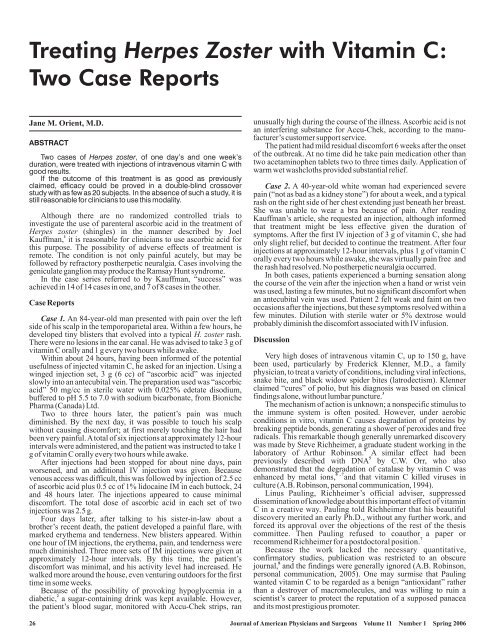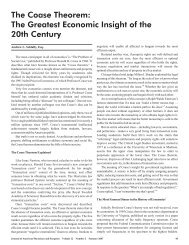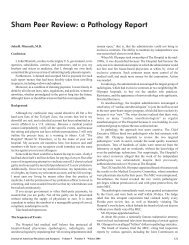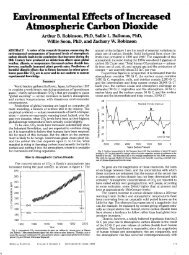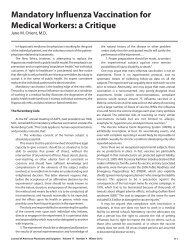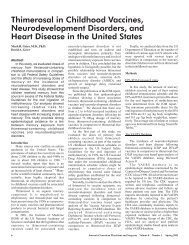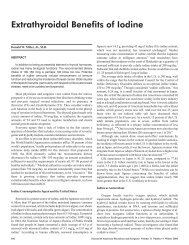Treating with Vitamin C: Two Case Reports Herpes Zoster
Treating with Vitamin C: Two Case Reports Herpes Zoster
Treating with Vitamin C: Two Case Reports Herpes Zoster
Create successful ePaper yourself
Turn your PDF publications into a flip-book with our unique Google optimized e-Paper software.
<strong>Treating</strong> <strong>Herpes</strong> <strong>Zoster</strong> <strong>with</strong> <strong>Vitamin</strong> C:<br />
<strong>Two</strong> <strong>Case</strong> <strong>Reports</strong><br />
Jane M. Orient, M.D.<br />
ABSTRACT<br />
<strong>Two</strong> cases of <strong>Herpes</strong> zoster, of one day’s and one week’s<br />
duration, were treated <strong>with</strong> injections of intravenous vitamin C <strong>with</strong><br />
good results.<br />
If the outcome of this treatment is as good as previously<br />
claimed, efficacy could be proved in a double-blind crossover<br />
study <strong>with</strong> as few as 20 subjects. In the absence of such a study, it is<br />
still reasonable for clinicians to use this modality.<br />
Although there are no randomized controlled trials to<br />
investigate the use of parenteral ascorbic acid in the treatment of<br />
<strong>Herpes</strong> zoster (shingles) in the manner described by Joel<br />
1<br />
Kauffman, it is reasonable for clinicians to use ascorbic acid for<br />
this purpose. The possibility of adverse effects of treatment is<br />
remote. The condition is not only painful acutely, but may be<br />
followed by refractory postherpetic neuralgia. <strong>Case</strong>s involving the<br />
geniculate ganglion may produce the Ramsay Hunt syndrome.<br />
In the case series referred to by Kauffman, “success” was<br />
achieved in 14 of 14 cases in one, and 7 of 8 cases in the other.<br />
<strong>Case</strong> <strong>Reports</strong><br />
<strong>Case</strong> 1. An 84-year-old man presented <strong>with</strong> pain over the left<br />
side of his scalp in the temporoparietal area. Within a few hours, he<br />
developed tiny blisters that evolved into a typical H. zoster rash.<br />
There were no lesions in the ear canal. He was advised to take3gof<br />
vitamin C orally and 1 g every two hours while awake.<br />
Within about 24 hours, having been informed of the potential<br />
usefulness of injected vitamin C, he asked for an injection. Using a<br />
winged injection set, 3g(6cc)of“ascorbic acid” was injected<br />
slowly into an antecubital vein. The preparation used was “ascorbic<br />
acid” 50 mg/cc in sterile water <strong>with</strong> 0.025% edetate disodium,<br />
buffered to pH 5.5 to 7.0 <strong>with</strong> sodium bicarbonate, from Bioniche<br />
Pharma (Canada) Ltd.<br />
<strong>Two</strong> to three hours later, the patient’s pain was much<br />
diminished. By the next day, it was possible to touch his scalp<br />
<strong>with</strong>out causing discomfort; at first merely touching the hair had<br />
been very painful.Atotal of six injections at approximately 12-hour<br />
intervals were administered, and the patient was instructed to take 1<br />
g of vitamin C orally every two hours while awake.<br />
After injections had been stopped for about nine days, pain<br />
worsened, and an additional IV injection was given. Because<br />
venous access was difficult, this was followed by injection of 2.5 cc<br />
of ascorbic acid plus 0.5 cc of 1% lidocaine IM in each buttock, 24<br />
and 48 hours later. The injections appeared to cause minimal<br />
discomfort. The total dose of ascorbic acid in each set of two<br />
injections was 2.5 g.<br />
Four days later, after talking to his sister-in-law about a<br />
brother’s recent death, the patient developed a painful flare, <strong>with</strong><br />
marked erythema and tenderness. New blisters appeared. Within<br />
one hour of IM injections, the erythema, pain, and tenderness were<br />
much diminished. Three more sets of IM injections were given at<br />
approximately 12-hour intervals. By this time, the patient’s<br />
discomfort was minimal, and his activity level had increased. He<br />
walked more around the house, even venturing outdoors for the first<br />
time in some weeks.<br />
Because of the possibility of provoking hypoglycemia in a<br />
2<br />
diabetic, a sugar-containing drink was kept available. However,<br />
the patient’s blood sugar, monitored <strong>with</strong> Accu-Chek strips, ran<br />
unusually high during the course of the illness. Ascorbic acid is not<br />
an interfering substance for Accu-Chek, according to the manufacturer’s<br />
customer support service.<br />
The patient had mild residual discomfort 6 weeks after the onset<br />
of the outbreak. At no time did he take pain medication other than<br />
two acetaminophen tablets two to three times daily. Application of<br />
warm wet washcloths provided substantial relief.<br />
<strong>Case</strong> 2. A 40-year-old white woman had experienced severe<br />
pain (“not as bad as a kidney stone”) for about a week, and a typical<br />
rash on the right side of her chest extending just beneath her breast.<br />
She was unable to wear a bra because of pain. After reading<br />
Kauffman’s article, she requested an injection, although informed<br />
that treatment might be less effective given the duration of<br />
symptoms. After the first IV injection of3gofvitamin C, she had<br />
only slight relief, but decided to continue the treatment. After four<br />
injections at approximately 12-hour intervals, plus1gofvitamin C<br />
orally every two hours while awake, she was virtually pain free and<br />
the rash had resolved. No postherpetic neuralgia occurred.<br />
In both cases, patients experienced a burning sensation along<br />
the course of the vein after the injection when a hand or wrist vein<br />
was used, lasting a few minutes, but no significant discomfort when<br />
an antecubital vein was used. Patient 2 felt weak and faint on two<br />
occasions after the injections, but these symptoms resolved <strong>with</strong>in a<br />
few minutes. Dilution <strong>with</strong> sterile water or 5% dextrose would<br />
probably diminish the discomfort associated <strong>with</strong> IV infusion.<br />
Discussion<br />
Very high doses of intravenous vitamin C, up to 150 g, have<br />
been used, particularly by Frederick Klenner, M.D., a family<br />
physician, to treat a variety of conditions, including viral infections,<br />
snake bite, and black widow spider bites (latrodectism). Klenner<br />
claimed “cures” of polio, but his diagnosis was based on clinical<br />
3<br />
findings alone, <strong>with</strong>out lumbar puncture.<br />
The mechanism of action is unknown; a nonspecific stimulus to<br />
the immune system is often posited. However, under aerobic<br />
conditions in vitro, vitamin C causes degradation of proteins by<br />
breaking peptide bonds, generating a shower of peroxides and free<br />
radicals. This remarkable though generally unremarked discovery<br />
was made by Steve Richheimer, a graduate student working in the<br />
4<br />
laboratory of Arthur Robinson. A similar effect had been<br />
5<br />
previously described <strong>with</strong> DNA by C.W. Orr, who also<br />
demonstrated that the degradation of catalase by vitamin C was<br />
6,7<br />
enhanced by metal ions, and that vitamin C killed viruses in<br />
culture (A.B. Robinson, personal communication, 1994).<br />
Linus Pauling, Richheimer’s official adviser, suppressed<br />
dissemination of knowledge about this important effect of vitamin<br />
C in a creative way. Pauling told Richheimer that his beautiful<br />
discovery merited an early Ph.D., <strong>with</strong>out any further work, and<br />
forced its approval over the objections of the rest of the thesis<br />
committee. Then Pauling refused to coauthor a paper or<br />
7<br />
recommend Richheimer for a postdoctoral position.<br />
Because the work lacked the necessary quantitative,<br />
confirmatory studies, publication was restricted to an obscure<br />
8<br />
journal, and the findings were generally ignored (A.B. Robinson,<br />
personal communication, 2005). One may surmise that Pauling<br />
wanted vitamin C to be regarded as a benign “antioxidant” rather<br />
than a destroyer of macromolecules, and was willing to ruin a<br />
scientist’s career to protect the reputation of a supposed panacea<br />
and its most prestigious promoter.<br />
26<br />
Journal of American Physicians and Surgeons Volume 11 Number 1 Spring 2006
Snake venom and other peptide toxins that are injected once in a<br />
limited dose would be prime candidates for treatment <strong>with</strong> a peptide<br />
destroyer. The organism receiving the vitamin C may also suffer<br />
some damage but is able to repair itself.<br />
During infections, the leukocyte ascorbic acid content<br />
9<br />
decreases. It is possible that vitamin C is sequestered for safe<br />
transport in leukocytes, from which it is released to generate<br />
peroxides and free radicals when needed to destroy invading<br />
microorganisms (A.B. Robinson, personal communication, 2005).<br />
Another possibility is that the burst of antigens released in<br />
the breakdown of macromolecules serves as a stimulus to the<br />
immunesystem.<br />
In the internet era, physicians may encounter patient demands<br />
10<br />
for a trial of Klenner’s protocols, especially in the event of lifethreatening<br />
infections for which no effective treatment exists,<br />
including viral encephalitis and pandemic influenza.<br />
Suggested Research Design<br />
As successes are far more likely to be reported than failures, a<br />
controlled trial would be highly desirable. But if patients are fully<br />
informed, it seems likely that many will not want to give consent to<br />
possible receipt of a placebo when they have a painful condition<br />
<strong>with</strong> a high likelihood of months—or even a lifetime—of pain<br />
requiring opioids for adequate relief. This is especially true <strong>with</strong> a<br />
treatment that is low in cost and apparently <strong>with</strong>out significant<br />
adverse effects. Therefore, a crossover design is needed.<br />
Patients could be randomly assigned to receive solution A or<br />
solution B, <strong>with</strong> both patient and investigator blinded to which is<br />
active, along <strong>with</strong> vitamin C capsules or placebo capsules matched<br />
to the solution. The vitamin C solution should be sufficiently dilute,<br />
or mixed <strong>with</strong> a local anesthetic, to prevent burning on injection.<br />
Three hours later, patients who do not have resolution or<br />
marked diminution of pain could receive the other solution and the<br />
other type of capsule. Three hours after that, the patient could<br />
decide which of the two solutions should be continued for a total of<br />
six injections. If the patient detects no difference, then the first<br />
substance would be used for the course. Patients should be<br />
evaluated soon after the last injection and at 1, 3, and 6 months for<br />
occurrence of postherpetic neuralgia. Outcome measures should<br />
include duration of rash, duration and severity of pain, and severity<br />
of constitutional symptoms.<br />
If treatment is as effective as Kauffman’s sources claim, a very<br />
small number of cases would be adequate to demonstrate the effect<br />
<strong>with</strong> a high degree of confidence. Using tools made available on the<br />
internet by DSS Research (www.dssresearch.com), one can<br />
determine the sample size that would be required under various<br />
assumptions about treatment and placebo effect and the desired<br />
confidence interval:<br />
If vitamin C gives rapid pain relief in 80% of cases, and placebo<br />
in 10%, only about 10 subjects would be needed in each group to<br />
show a statistically significant difference <strong>with</strong> P


